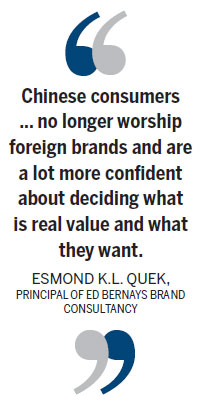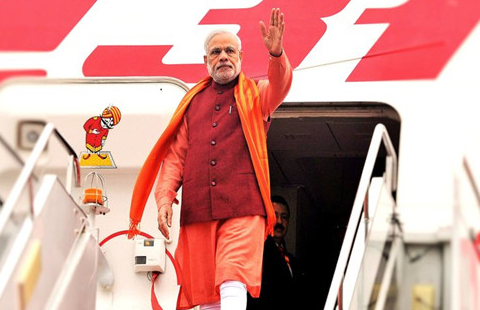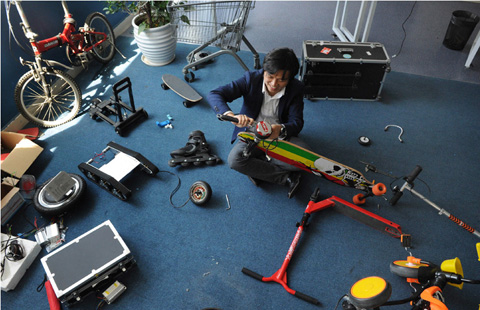
Multinationals should look to long-term development, not just seek a quick lift in sales
As Chinese consumers' tastes mature and gain in confidence, multinationals need to rethink their marketing strategies and find a balance between localization and maintaining their brand origin, says Esmond K.L. Quek, principal of Ed Bernays Brand Consultancy and former China CEO of Hill & Knowlton, a large public relations firm.
Quek's companies have served a number of multinationals, including Mapfre Insurance Co, Swire Properties Ltd and various luxury brands.
|
Esmond K.L. Quek, principal of Ed Bernays Brand Consultancy, says multinationals in China need to adapt to local market conditions and be more aware of their competitors' actions and respond accordingly. Provided to China Daily |
Over the past two decades, the competition landscape has changed in China, he says. "Chinese consumers used to look to foreign brands as the symbol of superiority and good quality, but now, as local players have matured, the gap in quality has diminished, and local companies tend to be more price-competitive without all the international baggage.
"Chinese consumers are more discerning and well-educated. They no longer worship foreign brands and are a lot more confident about deciding what is real value and what they want."
Multinationals in China need to adapt to local market conditions and be more aware of their competitors' actions and respond accordingly, Quek says.
For example, LeTV, a Chinese online video portal, compared every feature of its new smartphone with Apple Inc at the launch ceremony. "They are challenging Apple, and they are not shy about it."
Although Apple does not seem to be threatened for the time being, multinationals do have to get ready to face more challenges, Quek says. "They can either adopt a different business model like the Chinese competitors, or they need to build the brand so strong people will ignore the price disparity," he says. "Taking Apple as an example, they have done a good job making users loyal to their products, but if similar products hit the market, and if the price gap is so big, consumers may abandon them."

One disadvantage of multinationals is they are usually slower in making changes compared with local companies, Quek adds. "Chinese enterprises are much more adaptable to its changes; they will get their hands on right after they see an opportunity and will consider the details only afterwards. But multinationals base their decisions on data, which is more systematic, much slower."
Multinationals that entered the market early are evolving and responding to customer demands much quicker than they used to, "but new companies just coming to the market should learn their lessons so they don't need to go through learning cycles," Quek says.
Responding to customer demand means localization, yet how to do it properly is a complicated topic, he says.
"Generally, they need to consider several areas: product, price, promotion and distribution."
In consumer products, localization is a common tactic, he says. "To have a low price, multinationals need to localize the ingredients. For example, we often see international toothpaste or shampoo brands in green tea flavor, things that Chinese consumers will be drawn to. This is the most evident, superficial way of localization."
One thing multinationals need to bear in mind is that localization is good as long as the core competency is retained, he adds.
A good example of a localization for the market need is Volkswagen's Santana car model. "Santana's early success comes from the extended rear seat, based on the insight that most cars were chauffeur driven in China at that time. This single element was able to keep many competitors at bay and has now evolve to be a common practice for locally manufactured cars," he says.
However, Quek warns that, with a localized strategy, multinationals may meet a dilemma: localization brings down the price and raises the sales volume, yet it lowers the brand's image. "This is because companies overlook the importance of distribution channels," he says.
"Distribution will help determine the positioning," he says. "For example, Vidal Sassoon is a shampoo brand under the umbrella of Proctor & Gamble. When it was first launched, it was sold only in hair salons, but later the company wanted volume, so it is now sold in supermarkets. In the past, the price was almost double what it is now.
"If VS were still sold only in high-end salons, it would be associated with professionals, and the margin would be much higher. Now the price disparity between VS and other P&G shampoos is narrow, although the sales volume has increased. So which is more important, the brand image or the volume? This is a question for each multinational to consider."
When multinationals arrive in China, with its population of 1.3 billion, many cannot resist the attraction of sales volume, Quek says. But companies need to be patient and think long term for the brand, rather than concentrate on a boom in sales. 
Multinationals also need to be patient when it comes to staffing. "Sometimes a company requires a certain percentage of local managers, regardless of whether the market is ready. They build the talent pool quickly by promoting people only to find they are not ready. This happened a lot in the late 1990s, and afterward many multinationals had to reverse the trend," he says.
Over-localization can be especially dangerous for premium brands, Quek says. He cites the example of Lafite, which was an expensive, well-known wine brand often used for gifts. In 2008, Lafite introduced a new design and had an "8" engraved on top of the label to cater to Chinese people's love of the number. "To a real wine drinker, it was very tacky. It cheapened the brand at the cost of a long, healthy development", he says.
Quek admits that it is harder for luxury brands to cater to the Chinese market because they have to try to find a balance between the superiority of the brand and local tastes.
"They need to design campaigns very carefully, because they can help or harm the brand," he says. "It can be very sensitive."
There have been obvious success stories. "In the Year of the Horse, Hermes sold the horse theme, while Bulgari produced a range of snake-related designs in the Year of the Snake for Chinese shoppers. Both were big hits."
wangchao@chinadaily.com.cn
( China Daily Africa Weekly 05/15/2015 page32)








